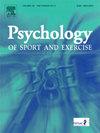Success in basketball shooting is better explained by less variability in quiet eye duration than the average quiet eye duration itself
IF 3.1
2区 心理学
Q2 HOSPITALITY, LEISURE, SPORT & TOURISM
引用次数: 0
Abstract
Gaze behavior termed quiet eye (QE), which is characterized by a fixation of long duration towards a task-relevant target at the moment of critical movement initiation, has been shown to be beneficial for performance in a variety of motor aiming tasks. Several studies, however, have questioned the effect of long QE durations for performance. Here, we show that the variability in QE duration across trials is a stronger predictor of aiming performance than the average QE duration per se. Twenty-six basketball players completed 100 free-throws with their eye movements recorded along with the free-throw accuracy. Results revealed that both the QE duration and variability were significantly correlated with free throw success rate. However, multiple regression analysis revealed that free-throw success was best explained by the QE variability (56 % explanatory rate). Mediation analysis also supported a model between QE duration and free-throw success rate mediated by QE variability. The results suggest that a longer QE duration may increase success by reducing QE variability. This provides new insights for understanding the association between QE and performance in aiming tasks.
与平均静眼持续时间相比,静眼持续时间的变化更小,这可以更好地解释篮球投篮的成功。
注视行为被称为静眼(QE),其特征是在关键运动开始的时刻长时间注视与任务相关的目标,已被证明有利于在各种运动瞄准任务中的表现。然而,有几项研究质疑长期量化宽松对经济表现的影响。在这里,我们表明,在不同的试验中,量化宽松持续时间的可变性比平均量化宽松持续时间本身更能预测目标表现。26名篮球运动员完成了100次罚球,并记录了他们的眼球运动和罚球的准确性。结果表明,量化宽松持续时间和变异性与罚球成功率均显著相关。然而,多元回归分析显示,罚球成功率最好的解释是量化宽松的可变性(56%的解释率)。中介分析也支持量化宽松持续时间与罚球成功率之间由量化宽松可变性介导的模型。结果表明,较长的量化宽松持续时间可能会通过减少量化宽松的可变性来增加成功。这为理解QE与瞄准任务中的性能之间的关系提供了新的见解。
本文章由计算机程序翻译,如有差异,请以英文原文为准。
求助全文
约1分钟内获得全文
求助全文
来源期刊
CiteScore
6.40
自引率
5.90%
发文量
172
审稿时长
69 days
期刊介绍:
Psychology of Sport and Exercise is an international forum for scholarly reports in the psychology of sport and exercise, broadly defined. The journal is open to the use of diverse methodological approaches. Manuscripts that will be considered for publication will present results from high quality empirical research, systematic reviews, meta-analyses, commentaries concerning already published PSE papers or topics of general interest for PSE readers, protocol papers for trials, and reports of professional practice (which will need to demonstrate academic rigour and go beyond mere description). The CONSORT guidelines consort-statement need to be followed for protocol papers for trials; authors should present a flow diagramme and attach with their cover letter the CONSORT checklist. For meta-analysis, the PRISMA prisma-statement guidelines should be followed; authors should present a flow diagramme and attach with their cover letter the PRISMA checklist. For systematic reviews it is recommended that the PRISMA guidelines are followed, although it is not compulsory. Authors interested in submitting replications of published studies need to contact the Editors-in-Chief before they start their replication. We are not interested in manuscripts that aim to test the psychometric properties of an existing scale from English to another language, unless new validation methods are used which address previously unanswered research questions.

 求助内容:
求助内容: 应助结果提醒方式:
应助结果提醒方式:


